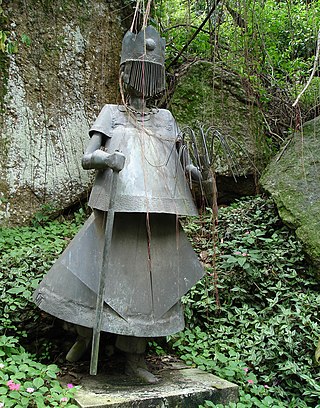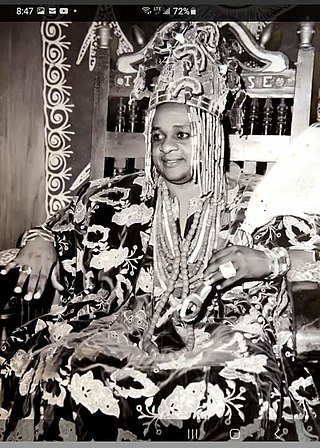Related Research Articles

Oshun is an orisha, a spirit, a deity, or a goddess that reflects one of the manifestations of the Yorùbá Supreme Being in the Ifá oral tradition and Yoruba-based religions of West Africa. She is one of the most popular and venerated Orishas. Oshun is an important river deity among the Yorùbá people. She is the goddess of divinity, femininity, fertility, beauty, and love. She is connected to destiny and divination.

Ọya is an Orisha of winds, lightning, and violent storms. As a river deity she is also regarded as a deity of children, able to provide children to her devotees or those who come to her banks at the Niger river.

The Oyo Empire was a Yoruba empire in West Africa. It was located in present-day eastern Benin and western Nigeria. The empire grew to become the largest Yoruba-speaking state through the organizational and administrative efforts of the Yoruba people, trade, as well as the military use of cavalry. The Oyo Empire was one of the most politically important states in Western Africa from the mid-17th to the late 18th century, and held sway not only over most of the other kingdoms in Yorubaland, but also over nearby African states, notably the Fon Kingdom of Dahomey in the modern Republic of Benin on its west.
Abiodun was an 18th-century alaafin, or king, of the Oyo people in what is now Nigeria.

Alaafin, or The custordian of the Palace in the Yoruba language, is the title of the king of the medieval Oyo empire and present-day Oyo town of West Africa. It is the particular title of the Oba (king) of the Oyo. It is sometimes translated as "emperor" in the context of ruler of empire. He ruled the old Oyo Empire, which extended from the present-day Benin republic to Nigeria, originating from states in the South East and West to the North. The people under him are called Yoruba people and spoke the Yoruba Language.
King Abipa, also known as Ogbolu or Oba M'oro, was an Alaafin of the Oyo empire. He is believed to have ruled during the late sixteenth and early seventeenth centuries.
Eguguojo was the Alaafin of Oyo during the sixteenth century. It was during his reign that the capital city was moved from Oyo ile to Oyo Igboho, after a protracted battle with the Nupes and also as a result of internal fighting. Prior to the establishment of New Oyo, his grandfather had gone on an odyssey from Oyo ile to escape threats from palace officials. He was succeeded on the throne by his sister Orompoto.
Ajiboyede was a successful but autocratic alaafin of the Oyo empire during the sixteenth century. He succeeded Orompoto.
Odarawu was an Alaafin of the Oyo Empire, who ruled briefly during the late seventeenth century. He was reportedly the first Alaafin to be rejected by the Oyo Mesi.
Kanran, or Karan, was an Alaafin of the Oyo Empire. He succeeded Oba Odarawu.
Jayin was an Alaafin of the Oyo Empire.
Aganju of Oyo was a Yoruba emperor of the Oyo state, in present-day Nigeria. He was said to have been the fourth Alaafin or old Oyo.

J. Lorand Matory is an American academic and Lawrence Richardson Professor of Cultural Anthropology and African and African American Studies at Duke University. Matory grew up in Washington, D.C., and attended Harvard College. He received his Ph.D. in anthropology from the University of Chicago in 1991, and currently he is Chair of the African and African American Studies department at Duke University. He is the author of Sex and the Empire That Is No More: Gender and the Politics of Metaphor in Oyo Yoruba Religion ; and Black Atlantic Religion: Tradition, Transnationalism and Matriarchy in the Afro-Brazilian Candomblé.
Oyo Igboho is a large town in Oyo State, Nigeria. It is the headquarters of the Orelope Local Government Area. It has an estimated population of 200,000.
The Ilorin Emirate is a traditional state based in the city of Ilorin in Kwara State, Nigeria. It is largely populated by the Yoruba-speaking people, though the kingdom is a hybrid state due to the influence of the many other tribes that make up the city.
The Yoruba people contributed significant cultural and economic influence upon the Atlantic slave trade during its run from approximately 1400 until 1900 CE.

Lamidi Olayiwola Adeyemi III was the Alaafin, or traditional ruler, of the Yoruba town of Oyo and rightful heir to the throne of its historic empire.

Oyèrónkẹ́ Oyěwùmí is a Nigerian gender scholar and full professor of sociology at Stony Brook University. She acquired her bachelor's degree in political science at the University of Ibadan in Ibadan, Nigeria and went on to pursue her graduate degree in Sociology at the University of California, Berkeley. Oyěwùmí is the winner of the African Studies Association's 2021 Distinguished Africanist Award, which recognizes and honours individuals who have contributed a lifetime of outstanding scholarship in African studies combined with service to the Africanist community.
Iyalawo is a term in the Lucumi religion that literally means Mother of Mysteries or Mother of Wisdom. Some adherents use the term "Mamalawo," which is a partially African diaspora version of the Lucumi term, Iyaláwo and Yeyelawo are two more versions of mother of mysteries. Ìyánífá is a Yoruba word that can be translated as Mother (Ìyá) has or of (ní) Ifá or Mother in Ifá & is the Yoruba title for Mother of mysteries & the female equivalent of a Babalawo.
Alaafin Atiba Atobatele was a prince of the Oyo Empire. He was the son of King Abiodun of Oyo, and Eni-olufan from Akeitan.
References
- 1 2 Harry George Judge; Robert Blake (1988). World history, Volume 1 (Volumes 3-4 of Oxford illustrated encyclopedia). Oxford University Press (University of Michigan). p. 266. ISBN 9780198691358.
- 1 2 3 Toyin Falola; Ann Genova (2006). The Yoruba in Transition: History, Values, and Modernity. Carolina Academic Press (University of Michigan). p. 427. ISBN 9781594601347.
- ↑ Jean Comaroff, John L. Comaroff (1993). Modernity and Its Malcontents: Ritual and Power in Postcolonial Africa. University of Chicago Press. p. 63. ISBN 978-0-226-1143-92.
- ↑ Oyeronke Olajubu (2003). Women in the Yoruba Religious Sphere (McGill Studies in the History of Religions). SUNY Press. p. 89. ISBN 9780791458860.
- ↑ Kulwant Rai Gupta (2006). Studies in World Affairs, Volume 1. Atlantic Publishers & Dist. p. 101. ISBN 9788126904952.
- 1 2 "Chronology of Oyo Kingdom's Alaafins". Odua Voice. Retrieved February 23, 2018.
- ↑ Oyèrónkẹ́ Oyěwùmí (2005). African Gender Studies: A Reader. Springer. p. 178. ISBN 9781137090096.
- ↑ J. Lorand Matory (2005). Sex and the Empire That Is No More: Gender and the Politics of Metaphor in Oyo Yoruba Religion (Berghahn Series). Berghahn Books. p. 84. ISBN 9781571813077.
- ↑ Basil Davidson (2014). West Africa Before the Colonial Era: A History to 1850. Routledge. p. 114. ISBN 9781317882657.
- 1 2 Matory, James Lorand (2005). Sex and the empire that is no more : gender and the politics of metaphor in Oyo Yoruba religion. Berghahn Books. ISBN 1571813071. OCLC 910195474.
- ↑ Samuel Johnson, Obadiah Johnson. The History of the Yorubas, From the Earliest of Times to the Beginning of the British Protectorate. p. 161.
- ↑ Smith, Robert (1965). "The Alafin in Exile: A Study of the Igboho Period in Oyo History". The Journal of African History. 6 (1): 57–77. doi:10.1017/s0021853700005338. ISSN 0021-8537.